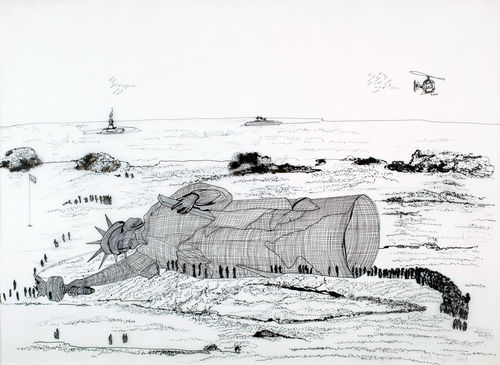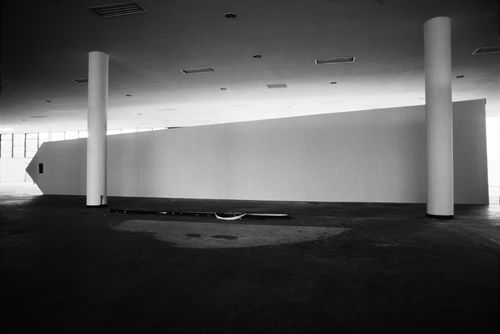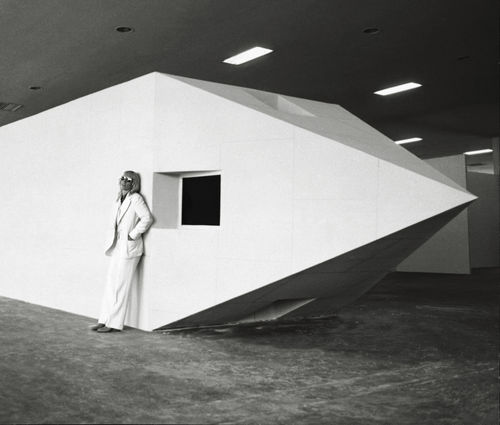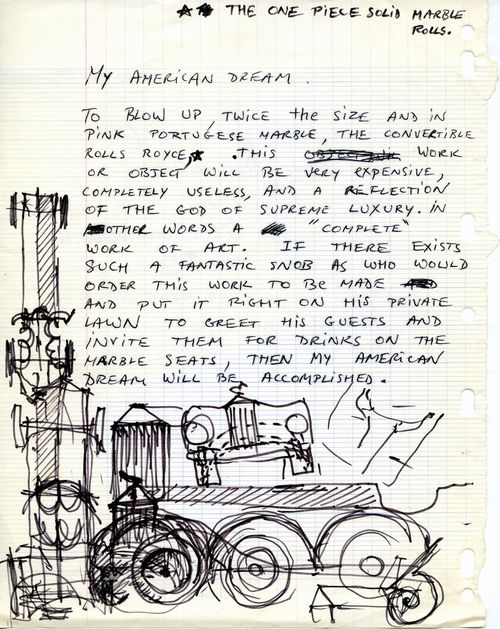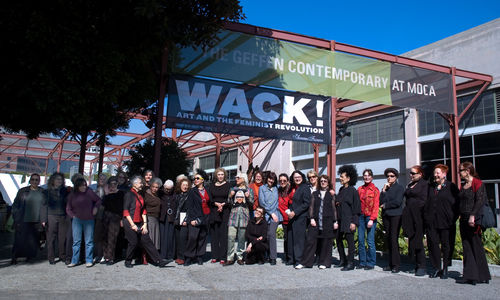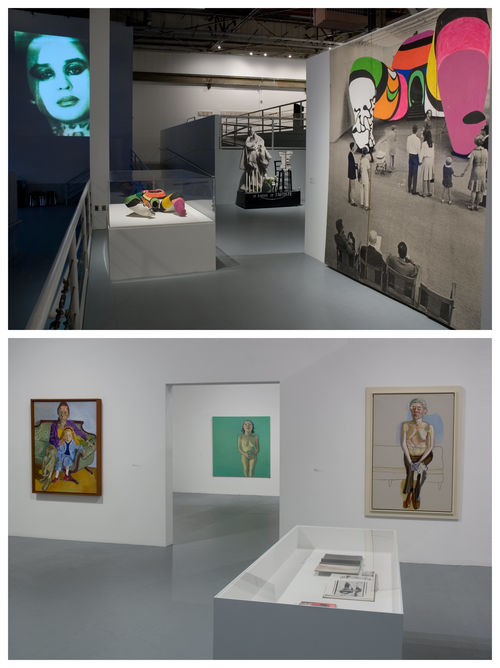Fallen Monuments
In 1979 the Argentine artist Marta Minujín made a conceptual proposal for the island of Manhattan. Intended for an open park site on the Hudson River, this massive public event, which she called a grand lunch, centered on a full-scale replica of the Statue of Liberty. Minujín's drawings for this event show Lilliputian figures lining up and entering the cavernous body of a hollow Lady Liberty, her prone figure occupying a huge piece of land. With the actual Statue of Liberty in distant view across the bay from Lower Manhattan, Minujín's monument stretches out like a fallen Gulliver, repurposed for a public gathering inside and outside her body. Published in 1979 in the journal produced by the Los Angeles Institute of Contemporary Art, Minujín's vision was part Dada action and part grand feminist gesture (fig. 1). The self-proclaimed inventor of happenings in South America proposed that the statue be covered with thousands of hamburger patties, "blanketing all surfaces, lips, eyes, head, and hands . . . half cooked hamburgers, side-by-side, completely covering the iron structure." Flamethrowers would be used to roast the patties, creating a monumental lunch to which, in the artist's words, all the world would be invited.# Massive in its ambitions and as subversive as it is humorous, the fallen monument is a symbol not only of the imperialist United States and its covert support of oppressive regimes across Latin America but also of patriarchy, cut off at its knees. The deposing of such a loaded (phallic) icon implied a deep reversal, a toppling of the imaginary of freedom and democracy that could come only from a citizen who had lived through dictatorship and through the double negative of being a woman in that repressive space.
During the 1970s Minujín imagined a number of sculptural projects, some realized and others not, that were extraordinary fantasies of scale and political desire. Coming toward the end of state-sanctioned terror in Argentina between 1976 and 1983, this prone Statue of Liberty mirrored a work titled El obelisco acostado (The obelisk lying down; figs. 2a and 2b), which Minujín made for the 1978 São Paulo Bienal, the first (and to date the only) one dedicated exclusively to Latin American art.# Describing the gesture and meaning of her deposed monument in the Brazilian context, Minujín said, "The Argentine Obelisk lying prone in the Latin American biennial in São Paulo was an aesthetic fact that altered visions and old symbologies. Everyday meanings were brought down and a new artistic conception came about; the law of gravity was altered (from vertical to horizontal), and an oblique state of consciousness was engendered among the spectators."# The oblique state of consciousness, a nonhierarchical space created by the fallen obelisk, conceptually abstracted as a hollowed-out tunnel-like space stretching across the floor of the biennial's grand pavilion, signals the radical rethinking of social and political strategies through a reimagining of the body. This gesture and spirit are at the heart of the feminist project as it played out internationally during the 1970s and into the 1980s. Repurposed for the American context, the notion of bodies inhabiting Liberty while enjoying open mass consumption is as much a comment on the culture of excess and plenty that the United States represents as it was part of the artist's ongoing critique of the dire situation of her own struggling country and its dying and deprived citizenry. Minujín's toppling of the patriarchy and its symbols through the idea of mass ingestion restores power to the people. The participatory contingencies of such a sculpture directly anticipate today's socially and publicly engaged art practices. The desire to constitute a public and perhaps to ignite social and political action is a legacy of feminist art without which the current fields of social practice and public engagement are not possible.
Working in Argentina, Minujín had little context for calling her work feminist, even as feminist politics emerged elsewhere, and it was her choice not to identify herself with a feminist position. Yet in the patriarchal context of the artistic field as it existed in Argentina, claiming feminism would have led to a devaluing of her status as "artist" beyond her condition as a woman artist. And still her fallen monuments resonate with projects conceived by women artists working internationally and in many different geographies between about 1965 and 1985. Consider, for example, Niki de Saint Phalle's magnificent sculpture Hon (1966; fig. 3), an enormous plaster and wire mesh figure of a pregnant woman whose cavity was accessed through an opening between her legs. Visitors queued up to enter the goddess, in whose interior space they would experience the kinetic sculptures of Saint Phalle's partner, Jean Tinguely. Or the double-life-size solid pink Portuguese marble Rolls-Royce that the Polish artist Alina Szapocznikow proposed in 1971 in a moment of chutzpah and outrage. In a handwritten proposal from 1970 titled "My American Dream," the artist describes a gigantic and useless monument to wealth, parked on a rich person's lawn and serving as the centerpiece of a decadent cocktail party (fig. 4).# She eventually exchanged correspondence with Harald Szeemann, the director of Documenta 5, but never participated in the exhibition after Szeemann asked her to find funding for the work, which was never fabricated.# These near inclusions, moments of aspirational grandiosity and failed attempts to challenge the male-dominated art world, are common to women practitioners around the globe. The desire to bring the audience, the average viewer and citizen, into direct contact with the history of heroically scaled objects and the hegemony of history's masculinist narratives and monument making is a deeply feminist impulse.
Radical Women: Latin American Art, 1960–1985, a historic exhibition that surveys the use and image of the political body by women artists from fourteen countries in Latin America and Latina artists from the United States, opens in Los Angeles a decade after WACK! Art and the Feminist Revolution (figs. 5 and 6). The first international exhibition to survey the art made in response to second-wave feminist politics, WACK! was organized by the Museum of Contemporary Art, Los Angeles. I curated the exhibition with a team of talented young women curators and scholars as well as a group of international advisers following a structure and methodology not unlike that of Radical Women.# Conceived initially as a survey of the North American feminist art movement, the exhibition shifted to be international in scope and chronology, mapping instead the intersections of feminist politics and art and arguing for parallel feminisms and artistic practices across nationalities. When the exhibition opened in 2007, it ushered in a decade of feminist-inspired projects that unearthed an unprecedented amount of material created by women artists whose work and careers had largely been erased from mainstream art history and contemporary consideration.
Focusing on the period from 1965 to 1980, WACK! was researched beginning in the late 1990s and early 2000s and was developed at a still early moment in global exhibition making. In 2007 the discourses of feminism in the United States and other Anglophone countries still tended to dominate what we knew of the feminist art of this period, so a number of projects that looked at feminist practices in Central and Eastern Europe, Asia, and the Middle East were undertaken in an effort to correct the historical record.# Curatorial research and practice in global exhibition making most frequently followed a methodology of looking out. That is, curators working with the full critical accountability of their own singular and geographically based subject position looked at artists from diverse cultures and tried to situate them without colonizing them. I am thinking here of Catherine David's Documenta 10 (1997) or Hans Ulrich Obrist and Hou Hanru's Cities on the Move (1997), both exhibitions that informed the curatorial strategy and structure of WACK! This global curatorial imperative, and a hunger for new readings of the 1970s, led to many international exhibitions of women and feminist artists that seemed to emanate from what Mignon Nixon has called the logic of the exploded archive, in which narratives are "stranded" in order to "unsettle existing categories of critical and historical reception."# Rather than making an argument, such exhibitions seek to complicate the already existing narratives of particular historical moments or lay out possible narratives where none previously existed. Radical Women, too, is organized around a deep archival impulse. What is fundamentally different in the case of Latin America and women's art is that many of the individual practices and narratives either have been lost or have not yet been constructed. It is from a sense of historical exclusion and a desire to see and understand a more complex history of Latin American and Latina art that this project was born.
Excerpted from Radical Women: Latin American Art, 1960–1985. Copyright © 2017 by the Armand Hammer Museum of Art and Cultural Center, Inc. Published by DelMonico Books, an imprint of Prestel. The full essay can be found in the exhibition catalogue, available here.
"To Turn or the Art of Turning: Marta Minujín," Journal: Southern California Art Magazine, no. 25 (November–December 1979): 49. Minujín's proposal was published with those of other important Latin American artists in an issue edited by Carla Stellweg focusing on art in Latin America.
Victoria Noorthoorn, Marta Minujín: Obras, 1959–1989 (Buenos Aires: Museo de Arte Latinoamericano de Buenos Aires, 2010), 110–11.
"To Turn," 48.
Szapocznikow wrote: "This work or object will be very expensive, completely useless, and a reflection of the god of supreme luxury. In other words a 'complete' work of art. If there exists such a snob as who would order this work to be made and put it right on his private lawn to greet his guests and invite them for drinks on the marble seats, then my American dream will be accomplished." The proposal and a model for the sculpture are illustrated in Elena Filipovic and Joanna Mytkowska, Alina Szapocznikow: Sculpture Undone, 1955–1972 (New York: Museum of Modern Art; Brussels: Mercatorfonds, 2012), 58, 59.
Jola Gola, "Chronology of Szapocznikow's Life and Work," ibid., 196.
My close collaborators on the exhibition—including Corrina Peipon, Jenni Sorkin, and Lisa Mark—were part of the curatorial staff at the Museum of Contemporary Art, Los Angeles.
See, for example, Gender Check: Femininity and Masculinity in the Art of Eastern Europe, Museum Moderner Kunst (MuMoK), Vienna, 2009, and Dream and Reality: Modern and Contemporary Women Artists from Turkey, Istanbul Modern, 2011.
Mignon Nixon, in Rosalyn Deutsche, Aruna D'Souza, Miwon Kwon, Ulrike Muller, Mignon Nixon, and Senam Okudzeto, "Feminist Time: A Conversation," Grey Room, no. 31 (Spring 2008): 32–67. This roundtable was one of the most productive discussions in the wake of the WACK! exhibition.



